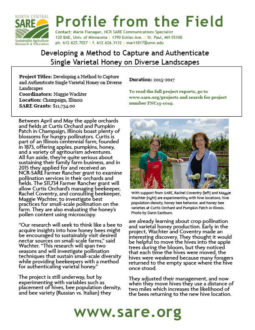Between April and May the apple orchards and fields at Curtis Orchard and Pumpkin Patch in Champaign, Illinois boast plenty of blossoms for hungry pollinators. Curtis is part of an Illinois centennial farm, founded in 1873, offering apples, pumpkins, honey, and a variety of agritourism adventures. All fun aside, they’re quite serious about sustaining their family farm business, and in 2015 they applied for and received an NCR-SARE Farmer Rancher grant to examine pollination services in their orchards and fields. The $11,734 Farmer Rancher grant will allow Curtis Orchard’s managing beekeeper, Rachel Coventry, and consulting beekeeper, Maggie Wachter, to investigate best practices for small-scale pollination on the farm. They are also evaluating the honey’s pollen content using microscopy.
“Our research will seek to think like a bee to acquire insights into how honey bees might be encouraged to sustainably visit desired nectar sources on small-scale farms,” said Wachter. “This research will span two seasons and will investigate pollination techniques that sustain small-scale diversity while providing beekeepers with a method for authenticating varietal honey.”
The project is still underway, but by experimenting with variables such as placement of hives, bee population density, and bee variety (Russian vs. Italian) they are already learning about crop pollination and varietal honey production. Early in the project, Wachter and Coventry made an interesting discovery. They thought it would be helpful to move the hives into the apple trees during the bloom, but they noticed that each time the hives were moved, the hives were weakened because many foragers returned to the empty space where the hive once stood.
They adjusted their management, and now when they move hives they use a distance of two miles, which increases the likelihood of the bees returning to the new hive location. They also plan to double their number of hives, and keep the hives stationary as possible, leaving them in their home apiary near the orchards but not moving them into the apple trees.
By collecting pollen samples from the target blooms and surrounding flora and comparing the samples to types and amounts of pollen found in the corresponding honey using a microscope, they have been able to start a library of common pollen grains found on the farm in order to develop a reference to identify pollen in honey. They intend to develop a guide for the sustainable production of varietal honey to help boost economic return for small-scale beekeepers. Learning to “think like a bee” has its rewards for Curtis Orchard and Pumpkin Patch. They recently won a grand prize in the 2016 International Black Jar Honey Contest put on by the Center for Honeybee Research.
For more information on Wachter’s NCR-SARE Farmer Rancher grant project, visit the SARE project reporting website or contact the NCR-SARE office.
View Rachel Coventry’s presentation on this project, from the 2016 Farmer's Forum, through NCR-SARE's Youtube playlist. Visit www.youtube.com/NCRSAREvideo from this and other videos.
